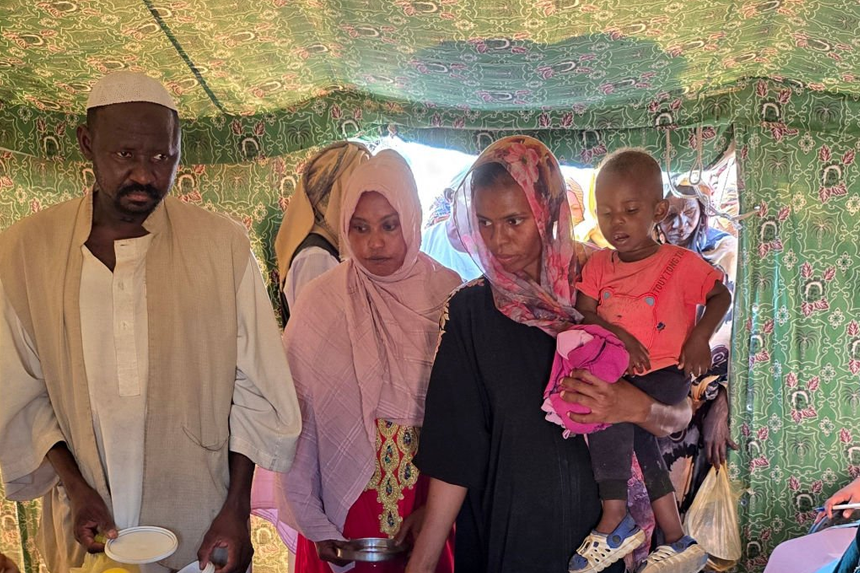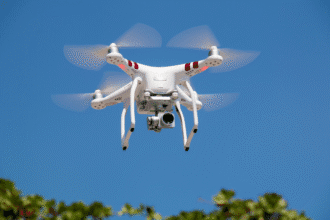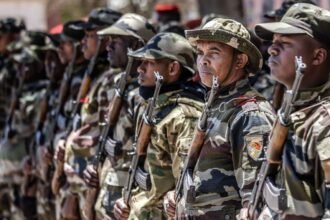The Sudan famine catastrophe in East Darfur is getting worse every day. Last month, thirteen children perished at the Lagawa displacement camp because there wasn’t enough food. The Sudan Doctors Network, which is made up of doctors operating in the camp, talked about the “deteriorating humanitarian conditions” and the rising number of children with severe malnutrition.
The continuous civil conflict, which has lasted for 27 months, has destroyed important infrastructure, forced families to leave their homes, and put thousands of people in dangerous and terrible living situations. Because of this, many people are starving, and the famine crisis in East Darfur is getting worse. Families have been split up, food prices have gone through the roof, and safe places to stay are getting harder and harder to find.
Most of the kids in the camp show signs of famine, like sunken eyes, weak limbs, and bellies that are too big. Parents can’t do anything while watching their kids get worse without food or medical care. These conditions make it clear how bad things are for thousands of people in East Darfur every day.
Why is famine spreading in Darfur?
Last year, famine was initially seen in camps in the western parts of Darfur. Things have gotten worse since then and have spread to East Darfur. Health experts say that the starvation crisis in East Darfur has gotten worse because of ongoing fighting, problems with getting supplies, and a lack of help.
Armed gangs have hijacked or obstructed many relief convoys, blocking off villages from supplies that could save their lives. In some places, families have to eat leaves, roots, or food scraps that aren’t safe. This is not only a bad situation; it’s a fatal one.
The Sudan Doctors Network said in a statement, “The international community and humanitarian organizations must act right away to bring food and medical care, especially for children and pregnant women.”
The famine is also getting worse because a lot of people have moved to camps that are already full, which is putting a strain on the few resources that are available. Diseases spread faster and malnutrition gets worse when there aren’t many resources and clean water. Because of the continued violence, local farmers can’t produce or harvest, which means there isn’t a consistent source of food. Read another article on Emergency Kitchens Close in Sudan
Who is in charge of East Darfur, and how does that affect relief efforts?
The paramilitary Rapid Support Forces (RSF) are in charge of East Darfur, which includes the city of el-Daein. This gang is fighting against Sudan’s army, which makes it hard for humanitarian groups to get help to the people. The war has made the starvation catastrophe in East Darfur worse, leaving families who have had to leave their homes in limbo.
Because the RSF controls important locations, humanitarian groups have to negotiate access, which can cause delays and restrictions. Aid workers have said they have been harassed or limited, and several groups have cut back on their activities because they are worried about safety.
Healthcare, water, and food systems have all broken down as infrastructure falls apart and violence rises. A local doctor said, “We are afraid that many more children will die without immediate help.” Roads have been devastated, making it practically impossible to go to faraway places. Even when help gets to el-Daein, it is quite hard to get it to people outside of the city.
What other health problems are caused by the crisis?
A cholera outbreak is now happening along with famine. Since June, the United Nations has confirmed more than 1,500 suspected and confirmed cases in Tawila. The disease has spread quickly because of bad sanitation, unclean water, and insufficient immunization rates.
Hospitals are too busy and don’t have enough tools. Patients have to travel for hours or even days to get care because many clinics don’t have access to clean water or antibiotics. This outbreak makes things much worse for a population that is already weak, making the devastating effects of the Sudan famine crisis in East Darfur even worse.
There are also more cases of diseases like measles, malaria, and diarrhea. Children who are malnourished are especially at risk because their immune systems are weak, making it hard for them to fight infections. Even ailments that can be treated will keep killing people who don’t need to die if there isn’t a coordinated health response.
What are the long-term impacts of the war on people living in Sudan?
Sudan has been in one of the world’s worst humanitarian disasters since the civil war started in April 2023. More than 12 million people have left their homes, tens of thousands have died, and about a million are at risk of starving.
This is a sign of a bigger collapse: the starvation disaster in East Darfur, Sudan. Displacement camps like Lagawa can’t get help from other countries and don’t have easy access to basic needs like food, medicine, or clean water. Women trek several miles to get water, and kids are taken out of school to assist their families to make ends meet.
The psychological impacts of war, being forced to leave your home, and famine will continue for a whole generation. A lot of kids will grow up without school or health care, which will keep them poor for decades.
A humanitarian aid worker observed, “This is not just a food crisis; it’s a complete breakdown of humanity.” “The world needs to act now, or it will lose an entire generation.”
What is being done, and what else has to be done right away?
Even while some humanitarian agencies are still working in small regions, their access is limited. The Sudan Doctors Network keeps pushing for quick action, asking for food shipments, mobile clinics, and safety for weak people.
The starvation catastrophe in East Darfur, Sudan, can only get worse if no action is taken right away. The risk is higher for kids and pregnant women. To make sure that life-saving supplies get to the people who need them, emergency airlifts, international pressure, and safe assistance routes are all necessary.
Sudan should be a top priority for governments, NGOs, and global health organizations. Rebuilding schools, hospitals, and local economies will also be necessary for long-term recovery. For now, though, the most important thing is to stay alive.
One doctor remarked, “Every hour we wait, another child is at risk of dying—not from gunfire, but from hunger and disease.”
Humanitarian groups say that the problem can still be solved, but only if everyone acts quickly and together. Lives can still be spared if there is political will, enough money, and well-planned logistics.








